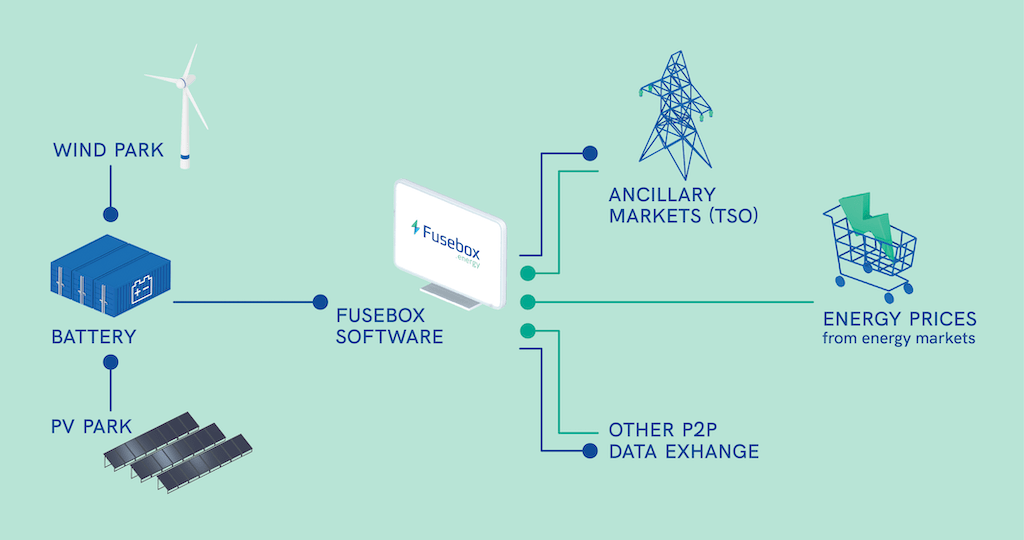As we shift from using fossil fuels to using renewable energy sources like solar, wind, and hydropower, batteries become essential. Batteries help integrate these intermittent energy sources into the grid, so there’s always energy available.
But, integrating batteries with renewable energy production, with local consumption, and into the energy market isn’t simple. Fortunately, providers like Fusebox have a solution to a complex operation. To help explain, here are 4 key terms central to the topic of batteries and the energy grid.
- Battery Energy Storage System (BESS): Batteries or groups of batteries that store electrical energy, capturing it when produced and releasing it when needed.
- Battery Management System (BMS): The electronic system that monitors and manages the battery system’s internal workings, such as its temperature and State of Charge (SoC).
- Smart batteries: Batteries that not only have a BMS but also link up to Virtual Power Plant (VPP) software via the cloud. Smart batteries are managed centrally and connect to the energy markets to help balance things out and stabilise the grid.
- Transmission System Operators (TSO): The companies responsible for transporting electrical power on a national or regional level and keep the grid balanced.
By 2025, intermittent renewables are expected to account for 35% of global electricity production – a figure projected to soar to 85% by 2050. At the core of this transformation are Smart Batteries. Curious about how they’re shaping the future of clean power? Here are six key insights, including how Fusebox is assisting companies on their journey to clean energy.
- Smart Batteries Increase the Reliability of Renewable Energy Production
We all know the weather can be unpredictable and that’s the tricky part with renewable energy – it’s not always consistent. Smart Batteries store extra energy when there’s a surplus and release it when needed, ensuring a consistent and dependable power supply even during the most intermittent conditions.
This allows renewable energy to become more reliable, helping us to reach that target of 85% by 2050.
- The BMS Safeguards The Battery

Modern energy storage systems have a built-in control unit known as the Battery Energy Management System, or the BMS, which safeguards the battery. It’s responsible for regulating voltage, current, and temperature when it’s charging up or giving out energy.
But, while the BMS looks after the battery’s health, it doesn’t connect it to energy markets and local consumption or allow for easy monitoring based on things like demand or frequency changes.
That’s where smart VPP software comes in. This software dynamically adjusts the battery’s output in response to real-time fluctuations in energy supply and demand. This optimisation is often referred to as ‘flexible energy’.
Fusebox’s Virtual Power Plant (VPP) is a champion of flexible energy. We provide these services to companies operating battery systems, giving them a more resilient and sustainable energy infrastructure as well as a new revenue stream.
- Smart Batteries Help Stabilise the Energy Grid
Smart batteries play a big part in keeping the energy grid stable. The VPP software behind them optimises the charging and discharging of batteries, allowing for efficient energy storage during periods of low demand and the release of stored energy during grid fluctuations. This balancing capability helps prevent overloads and ultimately makes the grid more stable.
Transmission System Operators (TSOs) are responsible for maintaining a stable electricity grid, and independent software providers like Fusebox work closely with them and asset owners to help them achieve this.
- Smart Batteries Create More Revenue Than Just Selling Energy
If you’re investing in batteries, the smart move is to play the energy market game and do energy arbitrage. You aim to charge up those batteries when prices are low and then sell that stored energy when prices are high. It’s all about maximizing your return.
The lesser-known spot in the energy world is the balancing market. The balancing market is also called the ancillary market and was created to incentivise market participants and help to keep the energy grid secure. The ancillary market is separate from the regular energy market (which is more focused on longer-term transactions) and instead focuses on balancing the market in real-time, managing imbalances between supply and demand.
For Battery Energy Storage System (BESS) owners, this balancing market is a source of revenue. They can offer these ancillary services to grid operators, where the prices are usually much higher than what you would receive from the traditional energy markets. For example, you can make up to €220,000 per year with a 1MW battery park in Finland through the ancillary market. In turn, this encourages companies that make energy storage systems to meet the technical requirements of these services.
Enter Fusebox’s Virtual Power Plant software. The VPP acts as a bridge to the balancing market, helping asset owners earn additional income. Our cloud-based platform manages multiple different energy resources such as batteries, renewables, and local power use. It tweaks their actions using information from both the balancing and regular energy markets, while also keeping an eye on each asset’s technical abilities and where it’s connected.
- Smart Batteries Help Battery Owners Comply with Complex Grid Regulations

If battery owners don’t follow the grid and connection point rules or guidelines, they can run into problems. For instance, if a BESS acts unexpectedly by charging or discharging, it can mess with the grid’s balance, causing voltage and frequency issues. Grid operators might charge fines for these disruptions. Plus, if a BESS doesn’t deliver promised services like frequency regulation or voltage support, the owner could face penalties.
With Fusebox, customers can easily meet these grid requirements with our smart automated solution, ensuring no one gets in trouble with the grid.
- Smart Software Supports Battery Health
Fusebox not only offers BESS owners financial benefits but also services to maintain the battery’s health and meet grid connection rules. Users have the flexibility to set various restrictions through the platform. These limitations can include shutting down operations based on overtemperature, setting time constraints, establishing limits on daily cycles, specifying usable State of Charge (SoC) ranges, and more.
The grid connection point may have rules on how much power it can send or receive, often set by the Distribution System Operator (DSO) or Transmission System Operator (TSO). These limitations are based on the voltage level at which the battery is linked to the grid. To regulate its power, the BESS needs integrated grid connection point measurements in line with these rules. However, meeting the requirements isn’t always easy due to technical limitations or the presence of other energy assets connected nearby.
With Fusebox, our VPP platform syncs seamlessly with the grid connection, making it easier to manage and follow the rules.
In Summary:
Smart Batteries are undoubtedly the future of sustainable energy, but to truly harness their full potential, they must be integrated with a Virtual Power Plant (VPP).
Fusebox has a competitive edge with many of its technical functionalities, but more importantly, it’s the seamless integration and automated control options that make it an easy-to-manage system. Our VPP platform allows battery owners to navigate complexities, optimise performance, and pave the way for a more resilient and sustainable energy landscape.
If you just can’t get enough of Smart Batteries and are interested in how Fusebox can help your business, watch our webinar.

